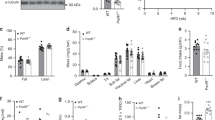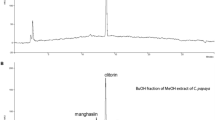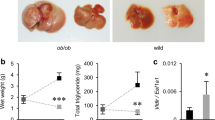Abstract
Insulin resistance is often associated with obesity and can precipitate type 2 diabetes. To date, most known approaches that improve insulin resistance must be preceded by the amelioration of obesity and hepatosteatosis. Here, we show that this provision is not mandatory; insulin resistance and hyperglycemia are improved by the modification of hepatic fatty acid composition, even in the presence of persistent obesity and hepatosteatosis. Mice deficient for Elovl6, the gene encoding the elongase that catalyzes the conversion of palmitate to stearate, were generated and shown to become obese and develop hepatosteatosis when fed a high-fat diet or mated to leptin-deficient ob/ob mice. However, they showed marked protection from hyperinsulinemia, hyperglycemia and hyperleptinemia. Amelioration of insulin resistance was associated with restoration of hepatic insulin receptor substrate-2 and suppression of hepatic protein kinase C ε activity resulting in restoration of Akt phosphorylation. Collectively, these data show that hepatic fatty acid composition is a new determinant for insulin sensitivity that acts independently of cellular energy balance and stress. Inhibition of this elongase could be a new therapeutic approach for ameliorating insulin resistance, diabetes and cardiovascular risks, even in the presence of a continuing state of obesity.
This is a preview of subscription content, access via your institution
Access options
Subscribe to this journal
Receive 12 print issues and online access
$209.00 per year
only $17.42 per issue
Buy this article
- Purchase on Springer Link
- Instant access to full article PDF
Prices may be subject to local taxes which are calculated during checkout






Similar content being viewed by others
References
Riccardi, G., Giacco, R. & Rivellese, A.A. Dietary fat, insulin sensitivity and the metabolic syndrome. Clin. Nutr. 23, 447–456 (2004).
Unger, R.H. Minireview: weapons of lean body mass destruction: the role of ectopic lipids in the metabolic syndrome. Endocrinology 144, 5159–5165 (2003).
Cai, D. et al. Local and systemic insulin resistance resulting from hepatic activation of IKKβ and NFβB. Nat. Med. 11, 183–190 (2005).
Arkan, M.C. et al. IKK-beta links inflammation to obesity-induced insulin resistance. Nat. Med. 11, 191–198 (2005).
Nakatani, Y. et al. Modulation of the JNK pathway in liver affects insulin resistance status. J. Biol. Chem. 279, 45803–45809 (2004).
Ozcan, U. et al. Endoplasmic reticulum stress links obesity, insulin action, and type 2 diabetes. Science 306, 457–461 (2004).
Howard, J.K. et al. Enhanced leptin sensitivity and attenuation of diet-induced obesity in mice with haploinsufficiency of Socs3. Nat. Med. 10, 734–738 (2004).
Inoue, H. et al. Role of hepatic STAT3 in brain-insulin action on hepatic glucose production. Cell Metab. 3, 267–275 (2006).
Torisu, T. et al. The dual function of hepatic SOCS3 in insulin resistance in vivo. Genes Cells 12, 143–154 (2007).
Shimano, H. et al. Sterol regulatory element-binding protein-1 as a key transcription factor for nutritional induction of lipogenic enzyme genes. J. Biol. Chem. 274, 35832–35839 (1999).
Shimano, H. Sterol regulatory element-binding proteins (SREBPs): transcriptional regulators of lipid synthetic genes. Prog. Lipid Res. 40, 439–452 (2001).
Horton, J.D. et al. Combined analysis of oligonucleotide microarray data from transgenic and knockout mice identifies direct SREBP target genes. Proc. Natl. Acad. Sci. USA 100, 12027–12032 (2003).
Lin, J. et al. Hyperlipidemic effects of dietary saturated fats mediated through PGC-1beta coactivation of SREBP. Cell 120, 261–273 (2005).
Ide, T. et al. SREBPs suppress IRS-2-mediated insulin signalling in the liver. Nat. Cell Biol. 6, 351–357 (2004).
Moon, Y.A., Shah, N.A., Mohapatra, S., Warrington, J.A. & Horton, J.D. Identification of a mammalian long chain fatty acyl elongase regulated by sterol regulatory element-binding proteins. J. Biol. Chem. 276, 45358–45366 (2001).
Matsuzaka, T. et al. Cloning and characterization of a mammalian fatty acyl-CoA elongase as a lipogenic enzyme regulated by SREBPs. J. Lipid Res. 43, 911–920 (2002).
Leonard, A.E., Pereira, S.L., Sprecher, H. & Huang, Y.S. Elongation of long-chain fatty acids. Prog. Lipid Res. 43, 36–54 (2004).
Wang, Y. et al. Regulation of hepatic fatty acid elongase and desaturase expression in diabetes and obesity. J. Lipid Res. 47, 2028–2041 (2006).
Maeda, N. et al. Diet-induced insulin resistance in mice lacking adiponectin/ACRP30. Nat. Med. 8, 731–737 (2002).
Weisberg, S.P. et al. Obesity is associated with macrophage accumulation in adipose tissue. J. Clin. Invest. 112, 1796–1808 (2003).
Xu, H. et al. Chronic inflammation in fat plays a crucial role in the development of obesity-related insulin resistance. J. Clin. Invest. 112, 1821–1830 (2003).
Nakae, J., Kitamura, T., Silver, D.L. & Accili, D. The forkhead transcription factor Foxo1 (Fkhr) confers insulin sensitivity onto glucose-6-phosphatase expression. J. Clin. Invest. 108, 1359–1367 (2001).
Wolfrum, C., Asilmaz, E., Luca, E., Friedman, J.M. & Stoffel, M. Foxa2 regulates lipid metabolism and ketogenesis in the liver during fasting and in diabetes. Nature 432, 1027–1032 (2004).
Zhou, G. et al. Role of AMP-activated protein kinase in mechanism of metformin action. J. Clin. Invest. 108, 1167–1174 (2001).
Samuel, V.T. et al. Mechanism of hepatic insulin resistance in non-alcoholic fatty liver disease. J. Biol. Chem. 279, 32345–32353 (2004).
Yu, C. et al. Mechanism by which fatty acids inhibit insulin activation of insulin receptor substrate-1 (IRS-1)-associated phosphatidylinositol 3-kinase activity in muscle. J. Biol. Chem. 277, 50230–50236 (2002).
Holland, W.L. et al. Inhibition of ceramide synthesis ameliorates glucocorticoid-, saturated-fat-, and obesity-induced insulin resistance. Cell Metab. 5, 167–179 (2007).
Samuel, V.T. et al. Inhibition of protein kinase Cepsilon prevents hepatic insulin resistance in nonalcoholic fatty liver disease. J. Clin. Invest. 117, 739–745 (2007).
Friedman, J.M. Obesity in the new millennium. Nature 404, 632–634 (2000).
Chakravarthy, M.V. et al. “New” hepatic fat activates PPARalpha to maintain glucose, lipid, and cholesterol homeostasis. Cell Metab. 1, 309–322 (2005).
Ntambi, J.M. et al. Loss of stearoyl-CoA desaturase-1 function protects mice against adiposity. Proc. Natl. Acad. Sci. USA 99, 11482–11486 (2002).
Dobrzyn, P. et al. Stearoyl-CoA desaturase 1 deficiency increases fatty acid oxidation by activating AMP-activated protein kinase in liver. Proc. Natl. Acad. Sci. USA 101, 6409–6414 (2004).
Shimada, M., Tritos, N.A., Lowell, B.B., Flier, J.S. & Maratos-Flier, E. Mice lacking melanin-concentrating hormone are hypophagic and lean. Nature 396, 670–674 (1998).
Loftus, T.M. et al. Reduced food intake and body weight in mice treated with fatty acid synthase inhibitors. Science 288, 2379–2381 (2000).
Elchebly, M. et al. Increased insulin sensitivity and obesity resistance in mice lacking the protein tyrosine phosphatase-1B gene. Science 283, 1544–1548 (1999).
Abu-Elheiga, L., Matzuk, M.M., Abo-Hashema, K.A. & Wakil, S.J. Continuous fatty acid oxidation and reduced fat storage in mice lacking acetyl-CoA carboxylase 2. Science 291, 2613–2616 (2001).
Neumann-Haefelin, C. et al. Muscle-type specific intramyocellular and hepatic lipid metabolism during starvation in wistar rats. Diabetes 53, 528–534 (2004).
Hiraoka-Yamamoto, J. et al. Serum lipid effects of a monounsaturated (palmitoleic) fatty acid–rich diet based on macadamia nuts in healthy, young Japanese women. Clin. Exp. Pharmacol. Physiol. 31 Suppl 2, S37–S38 (2004).
Kliewer, S.A. et al. Fatty acids and eicosanoids regulate gene expression through direct interactions with peroxisome proliferator-activated receptors alpha and gamma. Proc. Natl. Acad. Sci. USA 94, 4318–4323 (1997).
Wisely, G.B. et al. Hepatocyte nuclear factor 4 is a transcription factor that constitutively binds fatty acids. Structure 10, 1225–1234 (2002).
Perreault, M. & Marette, A. Targeted disruption of inducible nitric oxide synthase protects against obesity-linked insulin resistance in muscle. Nat. Med. 7, 1138–1143 (2001).
Hotamisligil, G.S. et al. Uncoupling of obesity from insulin resistance through a targeted mutation in aP2, the adipocyte fatty acid binding protein. Science 274, 1377–1379 (1996).
Maeda, K. et al. Role of the fatty acid binding protein mal1 in obesity and insulin resistance. Diabetes 52, 300–307 (2003).
Zambrowicz, B.P. et al. Disruption and sequence identification of 2,000 genes in mouse embryonic stem cells. Nature 392, 608–611 (1998).
Sekiya, M. et al. Polyunsaturated fatty acids ameliorate hepatic steatosis in obese mice by SREBP-1 suppression. Hepatology 38, 1529–1539 (2003).
Matsuzaka, T. et al. Insulin-independent induction of sterol regulatory element-binding protein-1c expression in the livers of streptozotocin-treated mice. Diabetes 53, 560–569 (2004).
Turinsky, J., O'Sullivan, D.M. & Bayly, B.P. 1,2-Diacylglycerol and ceramide levels in insulin-resistant tissues of the rat in vivo. J. Biol. Chem. 265, 16880–16885 (1990).
Nakagawa, Y. et al. TFE3 transcriptionally activates hepatic IRS-2, participates in insulin signaling and ameliorates diabetes. Nat. Med. 12, 107–113 (2006).
Kato, T. et al. Granuphilin is activated by SREBP-1c and involved in impaired insulin secretion in diabetic mice. Cell Metab. 4, 143–154 (2006).
Jiang, G. et al. Prevention of obesity in mice by antisense oligonucleotide inhibitors of stearoyl-CoA desaturase-1. J. Clin. Invest. 115, 1030–1038 (2005).
Acknowledgements
We thank T. Ide and H. Daitoku for technical help and/or useful comments. This work was supported by grants-in-aid from the Ministry of Science, Education, Culture and Technology of Japan; a grant for the Japan Foundation for Applied Enzymology; and a grant from The Naito Foundation.
Author information
Authors and Affiliations
Contributions
T. Matsuzaka carried out most of the experiments, data analysis and prepared the figures with significant help from M.I., S.O., N. Ishigaki, H.I., Y.I. and T. Karasawa. H. Shimano developed the idea for and supervised the study, designed protocols, developed collaborations and wrote the manuscript. N. Yahagi contributed to many in vivo experiments and to training T. Matsuzaka in experimental techniques. T. Kato carried out measurements of fatty acid composition and assisted with hepatocyte isolations, fatty acid treatment to the cell and mice and adenoviral experiments. A.A. assisted with the in vivo adenoviral experiments. T.Y. assisted with PKCε analysis and cell-line experiments. N. Inoue assisted with ELISA measurements and developed the DXA protocols for analyzing fat. S.K. assisted with RT-PCR analysis. T. Matsui contributed to primary myotube culture and the 2-DG uptake assay. M.S. and K.O. participated in the experimental design and in training T. Matsuzaka in experimental techniques. A.H.H. reviewed the manuscript. Y.N. contributed to immunoblot analysis of insulin signaling, adenoviral work and discussion of the results. A.T. contributed to GTT, ITT, HF-HS diet–feeding to the mice and discussion of the results. H. Suzuki, S.Y., H. Sone, H.T. and J.O. contributed to experimental design, data analysis, interpretation and presentation. N. Yamada supervised the study, contributed crucial ideas to the project and reviewed the manuscript.
Corresponding author
Supplementary information
Supplementary Text and Figures, Supplementary Table 1, Methods,
Supplementary Methods, Supplementary Figs. 1–5, Supplementary Table 1 (PDF 5161 kb)
Rights and permissions
About this article
Cite this article
Matsuzaka, T., Shimano, H., Yahagi, N. et al. Crucial role of a long-chain fatty acid elongase, Elovl6, in obesity-induced insulin resistance. Nat Med 13, 1193–1202 (2007). https://doi.org/10.1038/nm1662
Received:
Accepted:
Published:
Issue Date:
DOI: https://doi.org/10.1038/nm1662
This article is cited by
-
Sex differences in paternal arsenic-induced intergenerational metabolic effects are mediated by estrogen
Cell & Bioscience (2023)
-
Global analysis of the association between pig muscle fatty acid composition and gene expression using RNA-Seq
Scientific Reports (2023)
-
The fatty acid elongase Elovl6 is crucial for hematopoietic stem cell engraftment and leukemia propagation
Leukemia (2023)
-
Cannabidiol improves muscular lipid profile by affecting the expression of fatty acid transporters and inhibiting de novo lipogenesis
Scientific Reports (2023)
-
The LXRB-SREBP1 network regulates lipogenic homeostasis by controlling the synthesis of polyunsaturated fatty acids in goat mammary epithelial cells
Journal of Animal Science and Biotechnology (2022)



